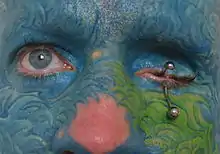Modern primitive
Modern primitives or urban primitives are people in developed, modern, post-colonial nations who engage in body modification rituals and practices inspired by the ceremonies, rites of passage, or bodily ornamentation in what they consider "primitive cultures".[1] These practices may include body piercing, tattooing, play piercing, flesh hook suspension, corset training, scarification, branding, and cutting. The stated motivation for engaging in these varied practices may be personal growth, personal rites of passage, or spiritual or sexual curiosity. In contrast to their usual purposes in the originating cultures, these practices are purposely taken out of their original "primitive" [sic] cultural contexts specifically to be reinterpreted in a "modern" cultural setting.


Modern origins
Roland Loomis, also known by his chosen name, Fakir Musafar, was one of the founders of the modern primitive movement.[2] The 1989 RE/Search book Modern Primitives is largely responsible for the promotion of the concept of modern primitivism. Among the modern primitive motivations, the main purpose of any rite of passage is to transform the adherent's state of being, from one state of existence to another. Modern primitives identify with a connection between what they see as "the primitive" and authenticity; “in opposition to the corruptions of mainstream society”.[3]
Modern primitives may have a loose set of beliefs about their way of life, including
- Modification of the body in order to sculpt their self-image.
- Activities which reject society at large. Exploring the self is a personal statement, which society rejects.
- Resisting what they see as colonialism, and identification with anticolonial struggles, despite being members of the colonial society themselves (sometimes described as engaging in cultural appropriation).[4]
References
- National Geographic - Ancient and Modern Tattoos Celebrated in Photography Book
- Gauntlet – decorating the Modern Primitive Archived 2007-05-20 at Archive.today
- Benson, Susan (2000). "Inscriptions of the self: reflections on tattooing and piercing in contemporary Euro-America". In Jane, Caplan (ed.). Written on the body: the tattoo in European and American history (Jane Caplan ed.). London: United Kingdom: Reaktion Books Ltd. pp. 234–254. ISBN 978-0691057231.
- Rosenblatt, David (1997). "The Antisocial Skin: Structure, Resistance, and 'Modern Primitive' Adornment in the United States". Cultural Anthropology. 12 (3): 287–334. doi:10.4135/9781526440211. ISBN 9781526440211. Retrieved 16 June 2019.
Further reading
- Vale, V.; Andrea Juno (1989). Modern Primitives. RE/Search. ISBN 978-0-940642-14-0.
- Pitts, Victoria L. (2003). In the Flesh: The Cultural Politics of Body Modification. Palgrave Macmillan. ISBN 978-1-4039-7943-8.
